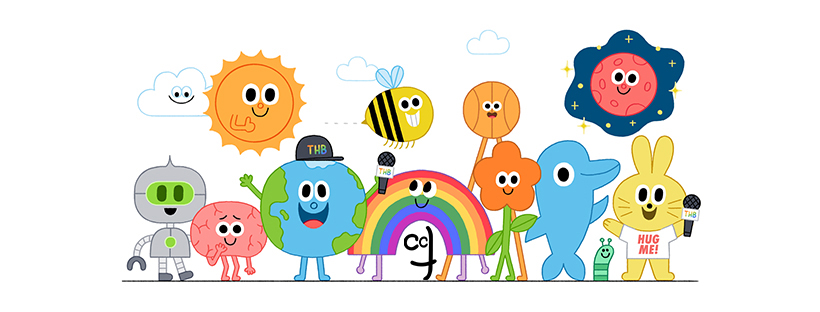
WORLD The world is not the frightening place told by the mass media. To demonstrate it, some communication and information professionals, in the field of creativity or journalism, have decided to take a radical position: to publish and share only good news! Together with Mauro Gatti, founder of The Happy Broadcast, we reflect on the reasons: from the inspirational power of good examples to mental health. But first let’s take a look at other “positive and constructive” editorial projects such as The Upside columns of The Guardian and Fixes by The New York Times, the pioneering Positive News magazine and the more recent Reasons to be Cheerful founded by artist and musician David Byrne. [Do you know any others? Comment the post!]
INDEX:
- A new journalism, positive and proactive
- From constructive journalism to civil advertising
- Interview with Mauro Gatti, founder of The Happy Broadcast
- CCTips
A new journalism, positive and proactive
“People like to read good news“ says the article’s title in which Mark Rice-Oxley of the British editorial team The Guardian presents the series The Upside, a column for good news inaugurated in February 2018 because “People are tired of bad news”, says the subtitle.
“News doesn’t have to be bad. The planet is complex. Away from the horror and conflict, the shouting and the skulduggery, away from the tragedy, disaster and zero-sum misanthropy, there is a wide world of answers and improvements, of win-win and mutual support, of selflessness and curiosity, of movements and innovations. And when you write about it, people tend to respond positively. They do so because while audiences have always been riveted by bad news (it serves as both an early warning system and a reassurance about the comfort of their own lives), they are tired of the avalanche of awfulness. They are switching off. That is a bad thing. If people just shrug at news because they feel there is little they can do, nothing will change. Journalists in the US, Europe and the UK are waking up to this by publishing what is variously described as constructive journalism, solutions journalism or, somewhat misleadingly, positive news. Now The Guardian is deepening its commitment to this type of work. Our new series, The Upside, launched […] to show readers all of humanity, not just the bad bits. […] As our editor-in-chief, Katharine Viner, promised in a speech on the future of The Guardian recently, “we will develop ideas that help improve the world, not just critique it. […] People long to feel hopeful again – and young people, especially, yearn to feel the hope that previous generations once had.”
They wrote this in 2018. Imagine today if, after two years of Covid-19 pandemic and the consequent economic and social crises, we need hope!
There are at least two other valid examples of this “new civil journalism” (which The Guardian itself cites or better links in its article). The Fixes column held in The New York Times by Mr. Bornstein and Ms. Rosenberg, two journalists who for eleven years, from 2010 to 2021, in about 600 articles, told about solutions put into practice in the world to various social problems (here is a their self-analysis on the editorial experiment). And then there is Positive News, the magazine founded in London in 1993 by Shauna Crockett-Burrows to do good journalism on good things: “When much of the media is full of doom and gloom, instead Positive News is the first media organisation in the world that is dedicated to quality, independent reporting about what’s going right. We are pioneers of ‘constructive journalism’ – a new approach in the media, which is about rigorous and relevant journalism that is focused on progress, possibility, and solutions. We publish daily online while the magazine is published quarterly in print. As a magazine and a movement, we are changing the news for good.”
Journalism must not only tell the problems but also the solutions. Knowing what good is happening in the world makes us know and hope that change is possible and this positive feeling can inspire people in their daily choices, small or big.
Positive News publishes positive news and stories about politics, society, environment, culture, science, health, food, energy, wellness, etc … every day from all over the world. And every week he collects the best in an article for the column “What went right this week”. For example, in one of the first weeks of this year 2022 it listed the following headlines: A four-day week trial was announced for the UK – A pristine coral reef was discovered off Tahiti – An app launched to help communities share stuff – A thousand fin whales were spotted near Antarctica – A rare bird returned to Argentina’s Iberá Wetlands – Millionaires called for higher taxes – A report highlighted the power of small gardens. Even the last couple of years have been filled with good news! Don’t believe it? Here you’ll find the best of 2020 and here those of 2021.
From constructive journalism to civil advertising
In 2019 an editorial project by artist and musician David Byrne was launched on the web, to share stories of solutions and positive change. The first tweet said “We’re launched! Visit reasonstobecheerful.world for a more optimistic and, we believe, more accurate depiction of the world. #wehaveourreasons” showing this video:
The editorial team of Reasons to be Cheerful was created to tell stories of intelligent, proven and replicable solutions to the most pressing problems in the world. Through accurate reporting, these stories spread optimism and hope. Partly magazine, partly therapy, the project aims to contribute to the construction of a better world by moving our curiosity towards change or at least an awareness: Things aren’t all bad.
“Plastic-Free Shopping Is Going Mainstream”, “Abandoned Oil Rigs Are Actually Helping the Oceans”, “How Norway Popularized an Ultra-Sustainable Heating Method”, “With This Company’s Support, Women Are Escaping Their Abusers” are some of the headlines of the many good news published only in January 2022: yes, it may sound strange to the newspapers that count the deaths from or with Covid daily but the pandemic is not the only thing that happens in the world.
Alarmism and feelings like anger or fear generate more clicks so more revenue from advertising. If newspapers had less to worry about selling and more about informing (which should be their job, right?) we would also read good news and related insights, perhaps. We know that “good news, no news” has always been the motto, the rule, the creed of journalism but in the digital age of the global village, the public has changed and has new needs. There is someone who has understood this and has decided to take a different path, against the current, proposing an alternative information that, in addition to generating interest, can be useful to the community because it is positive and proactive, inspirational and constructive: with the narration of good examples and virtuous practices that solve social, environmental, cultural problems, it is shown that the world is a place of innovation, progress and change; what is good and possible is replicable and nothing teaches more than example.
Even the world of advertising is aware of this: marketing experts are talking more and more about civic brands, brand purpose, brand activism, or social activism of companies and civil advertising. On the future of business communication, so that it has a future, we recommend listening to the Lectio Magistralis held at the Carlo Bo University of Urbino in November 2021 by Paolo Iabichino – aka Iabicus – (here is the podcast on Spotify, Italian). For Ipsos, again in 2021, Iabicus directed the Civic Brands Observatory: an editorial and research project created to investigate and tell the social commitment of companies and brands in Italy. The survey data from which the Observatory began is relevant: 1 Italian out of 2, if disappointed by the behaviour of a brand, would stop buying it. Corporate social commitment is a powerful buying driver. Also worth reading is The Newtrain Manifesto, which dates back to 2019 but it’s still very current.
Interview with Mauro Gatti, founder of The Happy Broadcast
As illustrator, you declare that your mission is “to spread happiness through quirky characters”. Born in Brescia in 1978, you currently live in California: in 2015 you moved to Los Angeles, where everyone surfs except you who instead deal with creativity by working on projects of various kinds, from illustration to creative direction, from publishing to game design. You have over 15 years of award-winning creative experience behind you, including an Emmy Award. But let’s get to the topic of our meeting. In 2018 you created The Happy Broadcast (THB), an editorial project that through a website and social media, then also a book and recently an App, collects and spread positive news from all over the world to promote a different culture from the mainstream one, that is positive, against hatred, anger and fear. Can you briefly tell us what THB is, how did the idea came out and how the project has developed over the years?
The Happy Broadcast was born as a response to the continuous bombardment of catastrophic news that reaches us on every device. Negative news is a proven cause of anxiety and it has a devastating effect on our positivity. This is why I decided to combine my creativity with the search for positive news from the world. The Happy Broadcast is a visual antidote to negativity, a visual pill that gives us hope and motivates us to do our part to help the progress of society. THB was born as an Instagram channel but then expanded into other collateral projects such as the WHOLE app and an eco-sustainable and charitable NFT project that we will launch shortly.
Do you know other editorial projects with a similar philosophy to THB? If so, which ones? And are there any in Italian?
Good News Movement, Upworthy, Tank’s Good News. These are some Instagram profiles that offer good news in video and photo format. I don’t know of similar Italian projects. If there is a person who would like to help me manage The Happy Broadcast project in Italian, I would gladly develop a version in our language!
On The Happy Broadcast you illustrate and share positive news told by verified sources around the world (by media such as Reuters, BBC, CNN, etc. or by organisations that make divulgation in their sector). With Covid-19, there seems to be only one topic to talk about but many other equally important and even positive things happen in the world! What changes have you been able to observe in the production/sharing/use of news in recent years?
I haven’t seen a lot of changes. To find the good news you have to dig a lot, the good news is certainly not the news you see on the front page. Much of modern infotainment is based on negative bias, that is the tendency we have, based on our survival instinct, to be attracted more to what is dangerous (think of 24-hour live broadcasts when there are disasters or cataclysms) than instead to what is positive.
You say you are very tired of all the bad news that media decide to spread and that today invade the screens of all our devices, from TV to PC, from tablet to smartphone. We are surrounded by scary headlines. In the past we had to go out to newsstands to know what was going on in the world. Today the news reaches us for free wherever we are and it’s not so easy to filter them and choose what to read, watch or listen to. Probably, especially after the last two years of pandemic, this tiredness you feel is an increasingly widespread and common feeling. Is a need for positive news really growing? Do the cultural and creative industries, publishing houses and media, perceive this need? How do they respond? In your opinion, is the so-called “constructive journalism” destined to remain niche or can become mainstream?
I hope there is a tendency to become more and more interested in good news in the future but I also hope it’s not a passive enjoyment, but a kind of inspiration to then act and do something. Negativity and positivity must coexist because if we are too unbalanced towards one or the other, we run the risk of ignoring the reality in which we live. I always say that positive news practically brings the solution to a negative event, but that solution requires the commitment of people. This is why I really hope that adding a little positivity to the daily news diet can give you hope and inspire you to be part of a solution to the problems that plague the world.
I’ve read that people notice and memorise more easily and that are also more responsive to negative stimuli (information or events) than positive or neutral ones. The scientific literature calls this “negativity bias”, which you mentioned above. It’s not a coincidence that an old international proverb says “no news, good news” that is: if you don’t get news from someone, things are likely to go well; journalism has take it by transforming it into a rule of the trade: the more negative news is, the more it sells, the good ones deserve little or no space. But what are the consequences on society and on individuals of information based on negativity, especially today that we live in the age of social media? New terms such as doomscrolling or doomsurfing define the habit (sometimes addiction) of spending a lot of time “scrolling” on feeds that are rivers of bad news, news that we (reacting more to negative stimuli) enhance with likes, comments and/or sharing, becoming more or less unconscious complicit victims of a global industry that produces pessimism, depression, anger, hatred, fear and that modifies the perception of reality. But fortunately we can all do something different to generate a positive impact! Based on your experience, what awareness and good practices can we implement?
Doomscrolling should definitely be limited. We must impose limits on the consumption of news. There must be also limits on the use of various devices, especially before going to sleep to limit stress and anxiety. Take care of your social feeds to eliminate some profiles that cause you anxiety and add some that are good for you, make you smile or give inspiration to do something useful for you and/or for others.
Instagram is the most followed social channel of The Happy Broadcast (to date it has over 628 thousand followers and is constantly growing). In its bio we read: Fact-checked ANXIETY-FREE NEWS from around the world that is good for our mental health. Mental health has become an important issue: the tools to combat the coronavirus such as social distancing and isolation have certainly limited the infection but also caused equally serious and harmful side effects for our health. What impact does the good news have on our mental health?
Good news clearly have an important impact on mental health. We think too much and often about the health of the body and little about that one of the mind. It also takes some kind of training to keep your mind fit. This is why I created the WHOLE app, to help people create positive daily habits that can help us be calmer, happier and at the same time more predisposed to help others.
In 2021, you illustrated 156 good news to show that the world is not the scary place the media represents. On Bored Panda magazine, every year since 2019, you publish a selection of the most beautiful and significant. So far, since you started The Happy Broadcast, what were the most important news for you that you have illustrated and shared? Give us some examples!
The news I love most in general are those that tell a story of the “power of one”, that is, those that make it clear how even a single person can, with determination, altruism and perseverance, make a difference and solve problems that would seem insurmountable. But also good news about animals are very important to me. Here are some of my favourites:
- Barn owls replace pesticides in California wineries
- Forest man of India planted a forest bigger than Central Park
- Underwater museum to save marine life
- Bee bus stops in Leicester
- Three endangered northwest killer whales are pregnant
The Happy Broadcast is also a book published in 2020 and an App called WHOLE. What is the book about and what is the application for?
The book (we are now working on a second volume) collects the best news and wants to be an object to give to people who need a “hit of positivity”. The app is a large and long-term project that will continue to develop over the years. We call it “the gym for the mind” because it contains dozens and dozens of activities that allow you to develop simple and healthy habits that can reduce stress, help you sleep, control your mood, increase kindness and predisposition towards others, etc… all based on scientific research. The app also includes a feed of positive experiences that users share every day, a kind of positivity carousel to give us the daily charge to smile! The WHOLE app can be downloaded for free here: https://getwhole.co
Any other projects in progress and/or that you would like to make with THB in the future?
I’m a tech enthusiast. The most interesting project I’m currently working on is an NFT project for The Happy Broadcast. Now NFTs (and crypto currencies) are under attack, rightly so, for their devastating environmental impact. We therefore looked for a crypto currency that was carbon-neutral (therefore with zero environmental impact) that could help us launch a project of collectible digital assets with the aim of promoting the culture of mental health and raising funds for various associations that deal with it, to help young people with mental disorders. In addition, every person who buys an NFT will get one year of access to our app as a gift. We want to spread the concept of “gym for your mind” as much as possible, especially to new generations of users.
Finally, what good news do you wish to illustrate and share on The Happy Broadcast soon?
I have no specific news in mind, I just hope that the number of positive news continues to grow and more and more problems can be solved thanks to all those fantastic people who, despite all odds, are dedicated to helping us and the world.

CCTips
- Make your library happy with the book illustrated by Mauro Gatti, The Happy Broadcast: How to stay positive, take action, and make the world a better place (Studio Press, 2020). You can find it on Amazon!
- Download for free the WHOLE App by The Happy Broadcast!
- Exercise your positivity by remembering every day to appreciate the little big free joys in life!
- Keep following CCT and if you like, join our world! 🙂





